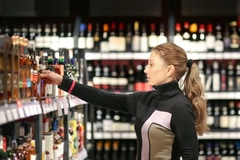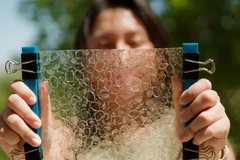
- Industry news
Industry news
- Category news
- Reports
- Key trends
- Multimedia
Multimedia
- Journal
- Events
- Suppliers
Suppliers
- Home
- Industry news
Industry news
- Category news
- Reports
- Key trends
- Multimedia
Multimedia
- Events
- Suppliers
Suppliers
Refined Packaging and Sustainability Need Not Be Mutually Exclusive

In addition to switching its cartons, Migros states that it wants to dispense with packaging within packaging, as well as generally reduce the amount of material it consumes and increase the share of recycled material in areas where migration doesn’t play a role.
Jan 12 2012 --- By 2013 Migros plans to reduce the environmental impact of the packaging of the 250 most commonly sold products by 10 per cent. Migros has already begun to switch over its UHT milk cartons, and a recent press release states that these cartons now bear the FSC label and are made of wood from forests cultivated in an environmentally compatible manner. This shows that sustainability is no longer just a slogan, but instead affects us all. Only companies that produce in a sustainable manner and manufacture sustainable products will be able to survive on the market in the future. The packaging industry has to make great efforts to meet this challenge. In addition to switching its cartons, Migros states that it wants to dispense with packaging within packaging, as well as generally reduce the amount of material it consumes and increase the share of recycled material in areas where migration doesn’t play a role.
In spite of this development, refined packaging continues to be in demand, especially in the confectionery segment. The sale of confectionery is improved time and again at the point of sale by extensively decorated consumer packaging featuring clever concepts. The packaging industry always has the right packaging variant available for its customers’ products, no matter what the contents. The variety of shapes and materials has further increased in recent years. The packaging mix leaves almost no wish unfulfilled nowadays, providing the right solution for everything from small-batch articles to mass produced products as well as from single portions to family-size packages or promotional items. Refined packaging seeks to affect all of a consumer’s senses in order to encourage him or her to buy the product in question. The chewing gum segment shows how much the packaging material helps to differentiate products. Re-sealable containers have become the standard kind of packaging for chewing gum, accounting for a continuously high share of turnover ever since they were introduced. In combination with new product concepts, re-sealable packaging creates added value.
According to Germany’s Statistical Office, the amount of confectionery produced in the country rose by 2.9 per cent in 2010, to 3.7 million tonnes. In terms of value, confectionery production increased by 3.9 per cent to €12.6 billion, thus rising back up to the level of 2008. The increase in turnover is mainly due to higher raw material costs. Buying confectionery in supermarkets has become a fascinating experience. Lebensmittel Praxis reports that the Rewe shop in Dortmund-Körne even has a "multi-dimensional" confectionery department. Leading confectionery manufacturers worked together with Rewe to create an “anchor brands concept”, which has now been implemented for the first time in a pilot project. In this concept, the sweet products are presented in all of their variety and diversity in pleasant surroundings and accompanied by music — the result is a multi-sensual experience. This upgrade of the confectionery range ensures consumers are guided by their senses and practically pulled into the new world of experience. The trade is now introducing this concept as well. Many confectionery manufacturers have been purposefully using lavishly designed packaging for many years, and this packaging can also be multi-dimensional. There is an obvious reason for this: In 2006, the "The Shopper at the POS" study by IRI and Pro Carton showed that packaging was a strong indicator of confectionery quality for 45 per cent of the people surveyed. However, less than 30 per cent of the respondents thought that this was also the case with rice, muesli, or detergent.
Packaging therefore plays a decisive role in the sale of confectionery. According to the study just mentioned, one in five consumers is willing to pay more for more lavish packaging. Women, in particular, want aesthetic or practical added value. Younger groups of buyers are willing to pay higher prices if they benefit from interesting features that create added utility, as is the case with the aforementioned chewing gum containers (in the form of multi-functional containers, for example). Today’s confectionery is multi-dimensional, meaning it has to be more than just functional, and target the senses. For holidays such as Christmas and Easter, products are sold by means of packaging that has a unique feel or produces sounds or music when opened. This trend has been in full swing for years. According to Pro Carton, such packaging allows products to cost up to 160 per cent more than comparable standard items.
However, this refinement does not run counter to another trend: sustainability. Leading paper refiners and manufacturers of individual presentation products are now also offering film and adhesives made of renewable raw materials. The biodegradable films that can be composted in accordance with DIN EN 13432:2000 include shiny and matte films as well as silver-metallized ones. They are made from cellulose or starch. All of the films bear the “compostable” label and can be used for food. They also have good barrier properties, can be used as sealants, and are stable in water. In addition to employing films and adhesives made of renewable raw materials, packaging manufacturers are exclusively using water-based adhesives to laminate films. Innovative UV paints are making the stars and starlets of sales packaging bright and glamorous in order to attract consumers’ attention. The more exclusive the packaging design, the more the glitzy highlights will grab people’s attention on the shelf. But unlike in the past, this is now often done in a sustainable manner.
The confectionery industry jumped on the sustainability bandwagon some time ago. Kraft Foods, for example, is offering Milka chocolate in Flowpack packaging, which can be resealed and no longer contains aluminium foil. Since 1991, Ritter Sport has been using a fully recyclable single-material packaging made of polypropylene. However, the efforts to differentiate chewing gums mentioned above also triggered an environmental “arms race”, which has caused the chewing gum containers to lose half of their weight since they were first introduced to the market in 2006. In addition, Wrigley has eliminated the paper wrapper of its Orbit stick chewing gum. The gum is now only packaged in a foil, thus saving 300 tonnes of paper per year. But this is just the beginning, because additional recyclable materials are currently being tested for use as packaging. Confectionery manufacturers are increasingly using sustainably produced raw materials, including certified grades of carton, bio-plastic and CO2-neutral packaging.
Source: Koelnmesse











